I. Where Is The Evidence Supporting Proof Of Afterlife?
1. Does Evidence Of The Mind As Space Exist
Proof Of Afterlife predicts that the mind changes dimension at death. Put another way, when conscious is being extinguished, it reacts in the opposite way of what you would expect. You would expect that consciousness being extinguished would be the end of the mind. Rather than being extinguished, evidence supports the mind doing the opposite. Evidence supports the mind opening, not closing. We see eyewitness accounts from people who have experienced their mind opening up. Proof Of Afterlife predicts it. Now we hear from people that have seen this happen.
2. Four Percent Of The Population Has Seen It
Approximately four percent of the population has experienced their mind as space as some point in their lives. Medical research describes these accounts as out of body experiences (OBE) and near death experiences (NDE). Medical research is at a loss of how to explain these accounts. How can a person suddenly find himself hovering above and looking down on their body? They don't know the answer. They explain this as random neural firing or dream like confusion. While they struggle to explain this phenomenon, we are absolutely clear about what has happened. Due to head trauma the mind as changed dimension going from a point in space to space. Now that the mind is space, consciousness can move about in the environment. When the mind is space consciousness can be anywhere within that space. Consciousness can be outside the body while still being inside the mind. Proof Of Afterlife eplains it. That is exactly what happens.
The mind becoming space is a quantum change. Conscious can exist in two states. It can exist as a point. It can also exist as space. The transition between the states is instantaneous and complete. About 96 percent of the population will never see their mind as space. They will go from birth to death with their mind as a point, never experiencing their mind as space.
3. What Causes The Mind To Change Dimension
What causes the mind to transition from point to space is trauma. To affect this change the trauma needs to be sufficient to extinguish consciousness. There are only two ways to extinguish consciousness. One is through physical trauma, such as a car accident or severe illness. The other is by drowning the environment with complexity (see virtual reality echo below). Of these methods trauma is by far the most common. You will never see your mind as space while staying within your comfort zone. Trauma of sufficient intensity required to affect this change is terrifying and dangerous. Near death means just that - near death. That is where you have to be to see this. That is why seeing the mind as space is so rare.
Evidence supporting Theory Of Afterlife is evidence of the mind becoming space. That evidence can only be found in instances where people have had their consciousness extinguished, have recovered, and lived to tell about it. Studies have shown that once a person sees their mind become space they never see life the same way again. Once you have experienced your mind as space you know that you are not going to die. The emotional affect reported by those who have seen their mind as space is positive.
To show that Proof OF Afterlife is true we need evidence of the mind as space. To find that evidence we look at out of body experience or OBE. To find that evidence we also look to near death experience or NDE. Thousands of accounts of OBE and NDE can't be explained away as happenstance, especially because they are strikingly similar. Proof Of Afterlife predicts the mind will change dimension. OBE and NDE tell us exactly what we would expect to see. That is evidence that the mind undergoes a quantum change in dimension at the end of life. It goes from a point within time and space to become time and space instantaneously. That is what people are seeing and reporting. There are thousands of eyewitness accounts of being who have been through this. Medical science may struggle to understand the mind as space. Proof Of Afterlife understands it perfectly.
II. Evidence Test Cases
1. Evidence Case: Near Death Experience (NDE)
1. Eye Witness Accounts Before The End Of Live
Surveys suggest that approximately 4.2 percent of the population has reported an NDE. It is estimated that more than 25 million individuals worldwide have had an NDE in the past 50 years. Proof Of Afterlife asserts that at the end of life is awareness transitions from point to space. This is a dimensional change in both time and space. This transition is from being a point of view within time and space TO all of time and space. The transition takes place in an instant. Here is a diagram of awareness lduring life. Here we are looking from the inside (awarness) out (memory).

Near death experience refers to personal experiences associated with the end of life. These are usually reported after someone has been pronounced clinically dead. Reports by people who have had near death experience are similar. Here are the descriptions of a people having experienced a near death experience.
2. Eye Witness Accounts At The End Of Live
One of the most striking aspects of NDE is how similar they all are. If such visions are random firing of brain cells they should all be wildly different. The trouble is they are strikingly similar. One of the classic components of a near-death experience is meeting dead relatives on the other side. Could it be that NDE are the same because that's what happens when we die? For example, 24% said that they had had an out-of-body experience, 31% remembered moving through a tunnel, and 32% reported meeting with deceased people. In one study 41 unconnected people from 10 different hospitals recalled nearly-identical NDE experiences.
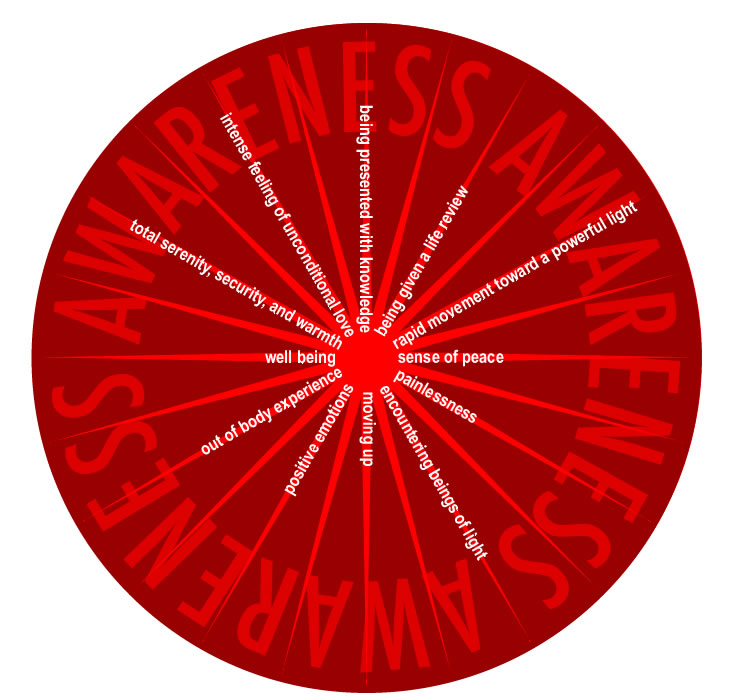
In the previous example awareness was the tiny red dot in the middle of the system. In this illustration awareness has expanded outward throughout memory. People seeing this have reacted with the following statements. These are the types of statements you would expect from someone undergoing dimensional change at the end of life. They seem pretty accurate to me.
Near death experience is the closest look we get at afterlife during life. Millions of people claim to have had a near death experience. The accounts they come back with provide real physical evidence as to what happens at the end of life. The evidence they come back with is similar. Afterlife appears to be a common experience. Near death experience as a common phenomenon exists is real.
Evidence: Theory of Afterlife predicts the mind becomes God at the end of life. The consistency of NDE accounts (out of body experience, overwhelming love, tunnel, light, life review, unlimited knowledge, and meeting other beings) is striking. There is no plausible biological explanation of NDE, however Memory As Dimension predicts it perfectly.
2. Evidence Case: Out Of Body Experience (OBE)
An estimated seven million people have reported hauntingly similar "near-death" out of body experiences. There is medical evidence that occurs rarely where a person is temporarily transported outside their body. The condition appears to occur in cases of extreme physical trauma or mental trauma. The person experiencing this condition usually describes it as a sensation of floating outside one's body, in some cases perceiving one's physical body from a place outside the body.
Out of body experience doesn't happen often but it does happen. It happens often enough to be written about in medical journals and generally accepted as a medical condition. Neurologists know that the condition exists and are looking for an explanation.
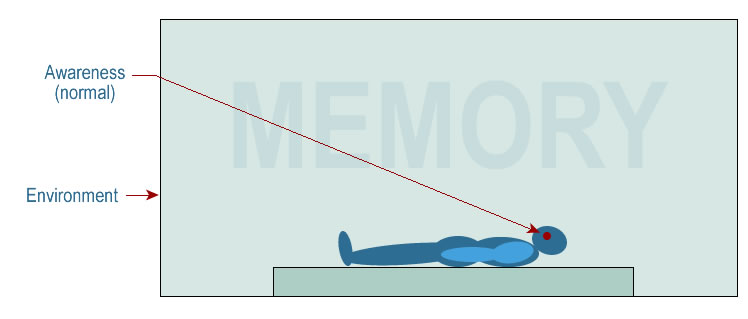
If out of body experience were a figment of imagination, then all the cases wouldn't be described the same. The experience is the same for many patients. The fact that the all the descriptions of the condition are similar indicates that something real is going on.
Out of body experience provides a test case for this theory because the theory states that life is made up of both conscious awareness (a point of view) and memory (surrounding space). What makes out of body experience possible is that memory is actually the space around you. During life our point of view is within our head but it doesn't necessarily need to be so. Since memory is the space around you, yet it is within the mind, it makes it physically possible to have a point of view somewhere outside the physical body. The point of view, while located outside the body, is still located within memory as shown here:
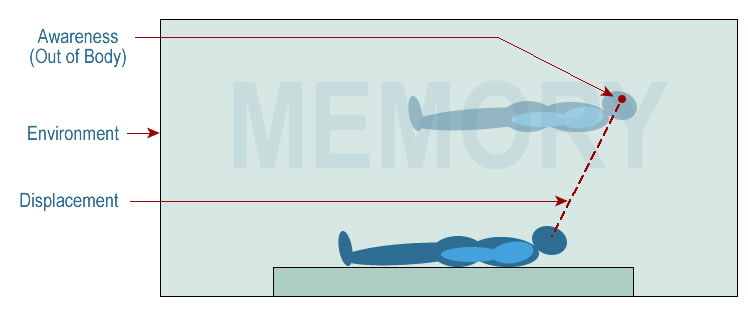
Patients experiencing this phenomenon often describe it as floating above their body. What is happening is their point of awareness has moved from its usual spot to another point within then environment. However since the environment is memory this is entirely possible. Awareness (under extreme and rare conditions) can move within memory. When it does the patient is dangerously close to the end of life. This would only happen during extreme trauma.
When you see reality as memory you can see how this can happen. Memory is the space around us. Put another way, we are contained within memory. Memory is the vehicle that allows the conscious mind to be transported outside the body where it attains a different point of view.
Out of body experiences are real. The point of view moves out into the world yet it is still contained within memory. Memory as surrounding space allows this to happen.
Evidence: During OBE the subject feels that he has left his body. He can look down and see it, often describing the sight of doctors working on him. During OBE the mind has transitioned from point to space. With the mind as space consciousness can move outside the physical body while remaining inside memory. OBE is predicted by memory as dimension.
3. Evidence Case: Dreams, The Mind's Virtual Reality
Picture memory as a large body of water. Awareness sits on the surface of the water. The surface is the present. As long as awareness is located on the surface, you are awake.
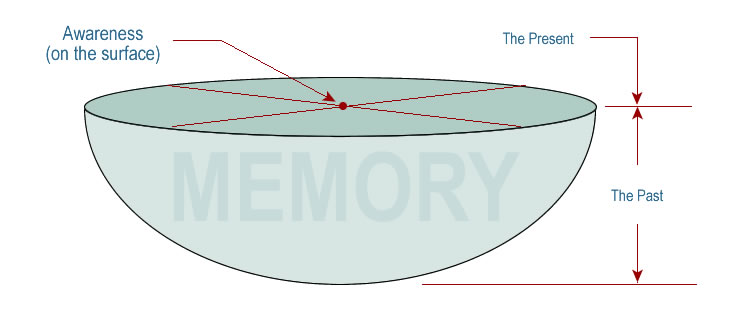
If you are trying to get to sleep, as long as you are thinking rational thoughts you will not go to sleep. Only when you begin to think irrational thoughts - thoughts that do not makes sense - are you beginning to fall asleep. Staying conscious and in the present will not bring about sleep.
Think of it as a dot sitting on the surface of a lake. When you begin to fall asleep it is as if the dot begins to sink below the surface. What is happening is your conscious awareness is going back into your memory. The mechanism that allows this to happen is memory being time and space. It is a physical space/time where the mind can go.
During sleep, the conscious mind remains submerged below the surface. It is transported back into memory where it resides. If there is a noise - such as an alarm going off - it will return to the present. The conscious mind comes up from being submerged to return to the surface of the lake. When the conscious mind reaches the surface (the present) we wake up. Awareness returns to the present moment.
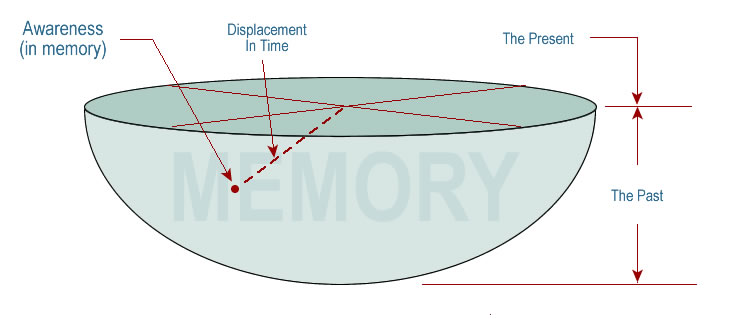
The key point is the place we go during sleep is just as real as reality. The events, thoughts, and physical space during sleep are just as real as reality in the present. This provides proof that memory is physical time. During sleep awareness wanders through memory back in time. Sleep provides evidence that memory is time and awareness is present within that time. The environment during sleep is just as real as the environment while awake. There is no difference between the two.
Out of body experience and sleep shows that awareness can travel within time and space. Awareness is not necessarily confined to the present. Awareness is able to travel into the outside world and back in time because while outside the body, it is still inside memory.
Evidence: Dreams show that memory is a four dimensional realm. During dreams consciousness can travel about throughout time and space while still being within the mind. While dreams do not show consciousness changing dimension like NDE and OBE, it does provide evidence that memory is a four dimensional realm that is not dependent upon the physical body.
4. Evidence Case: Hyperthymestic Syndrome
1. What Is Hyperthymestic Syndrome
Hyperthymestic Syndrome is a condition of super memory. Currently there are very few people in the world with this condition. Hyperthymestic comes from the Greek word hyper (meaning excessive) and thymesis (meaning remembering). People with Hyperthymestic Syndrome are described as having off the charts memory. They can describe what they were doing and world events for almost every day of their life. Unlike most people, whose memory fades over time, memories remain indelibly etched in the mind. When asked about it they just say that, "it's just there." To people with this condition perfect remembering does not seem like anything extraordinary.
2. Normal Memory
To explain how Hyperthymestic Syndrome works and how it supports the theory of afterlife, look at this diagram.
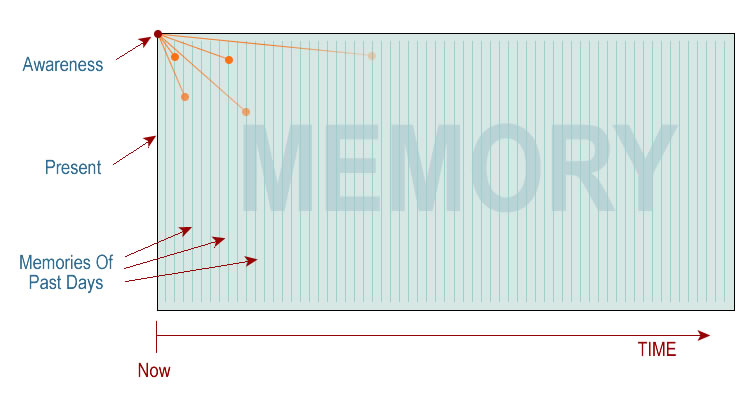
This is a depiction of normal memory. The large box represents memory - the experiences of a person throughout a lifetime. The red dot (in the upper left corner) represents awareness. The left leading edge represents the present.
The orange lines and dots represent the average person's ability to remember. For example, the second orange dot (from the left) represents remembering an event that happened three days ago. Notice how the memory of events fades (isn't as clear) as you get further away from the present.
3. Hyperthymestic Memory
Compare a normal person's memory with the diagram of a person with Hyperthymestic Memory below. Notice how much more of memory awareness can access. They can access more events and access them clearer. Hyperthymestic Syndrome is an enhanced ability to look back into memory at moments of the past. The person with this condition can access memory easier and more completely than the rest of us.
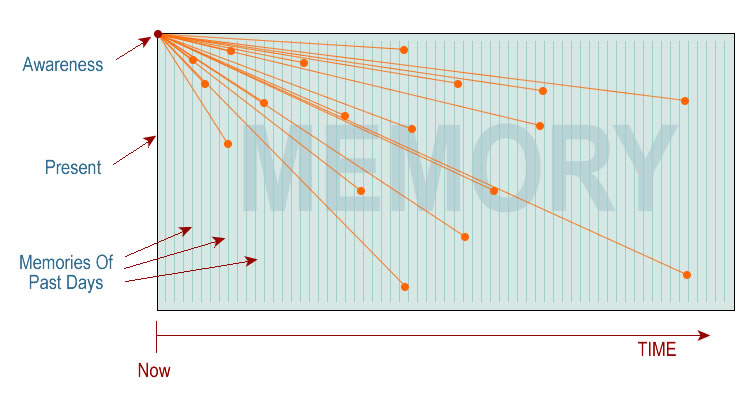
Notice that in both cases (normal and Hyperthymestic Memory) the size of memory and the size of awareness is the same. The difference between the two is the enhanced ability to remember. The reason Hyperthymestic Syndrome serves as evidence of proof of afterlife is because it testimony to the vastness and completeness of memory. In other words, if memory were not complete in every detail then the Hyperthymestic person would have nothing to remember. It provides evidence that the memory is there, that it exists, and it can be accessed at any time.
Like the Hyperthymestic person, we too have perfect memory. Out ability to recall from our memory is limited, however that does not diminish memory itself. The logical question becomes, why would we have perfect memory if we can't access it. The answer is that we will use it at the end of life. At the end of life we will realize this huge store of information we have gathered throughout a lifetime. The Hyperthymestic person can access it (remember from it) better than we can. However, they too can only access the tiniest fraction of what is there. It is just that their tiny fraction is several times larger than our tiny fraction.
Evidence: Hyperthymestic Syndrome shows the vastness and completeness of memory that is within us all. It suggests that memory is unlimited, capturing everything that happens during life in full detail. Memory is actually a time-space realm built during life. It is our ability to recall from memory that is limited, not memory itself.
III. Virtual Reality
1. Geometry Of Virtual Reality and Afterlife
For 50 I have been on the lookout for anything close to Theory Of Afterlife. I've been on daily watch for someone else with a proof of afterlife like this one. During all 50 years nothing in the news has come close. The one thing that is close however, is virtual reality.
Virtual reality is a complete environment generated by a computer. Using special glasses and equipment we can place ourselves in this environment. We are able to walk through it and experience it. As computer resolution gets better, virtual reality will become indistinguishable from reality. This brings up the question, what is the difference between virtual reality and real reality?
The geometry of virtual reality is a camera within an environment. This is the exact same geometry as life. We are like camera within an environment. There is a point to space relationship in a virtual environment. The camera is located at a point. It is surrounded by space. This point to space relationship holds true in life. Like the camera, awareness is a point. The environment surrounds it. The environment is memory. In both virtual reality and life the geometry is the same.
During life awareness functions as the camera. It is located as a point. It has specific X, Y, and Z coordinates within the space. Here is a picture of a virtual reality program called Cheetah 3D. It is excellent software. You can purchase it here.
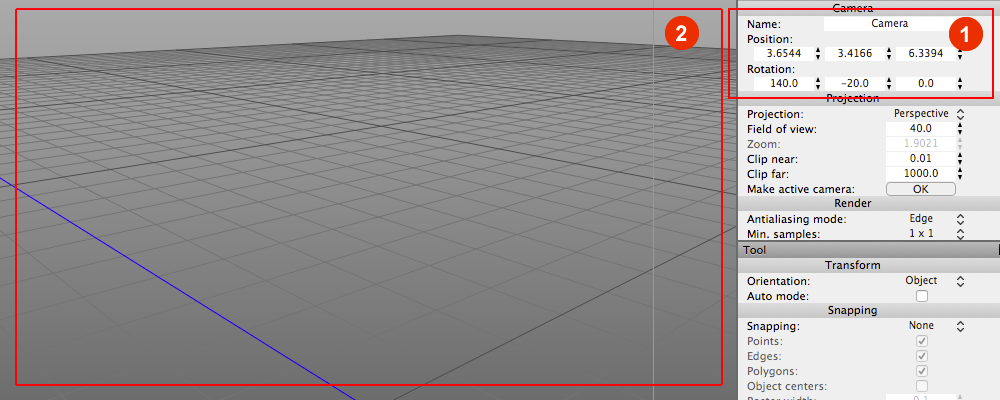
1) The first thing to notice is the camera controls located at the upper right. These controls show the exact location of the camera within the space in X, Y, and Z coordinates. The next line below shows the rotation, left-right, up-down, and tilt.
2) On the left is the view of the environment from this location. We can move the camera by altering these parameters. For example if I change the rotation I can cause the camera to pan right. If I change the 2nd parameter I can cause the camera to pan down. If I change the position parameters I can move the parameter around in space. I can change the Z parameter, moving the camera up.
This is how we go through life. Our conscious awareness functions exactly like the camera in virtual reality. Like the camera, conscious awareness has X, Y, and Z location within space. Like the camera, is has rotation about length, width, and depth. The camera and conscious awareness are virtually identical. They function exactly the same. During life we are at a location (1). From that location we look out at space (2).
2. Virtual Reality And OBE
Now what I've done is add a second camera to the scene.
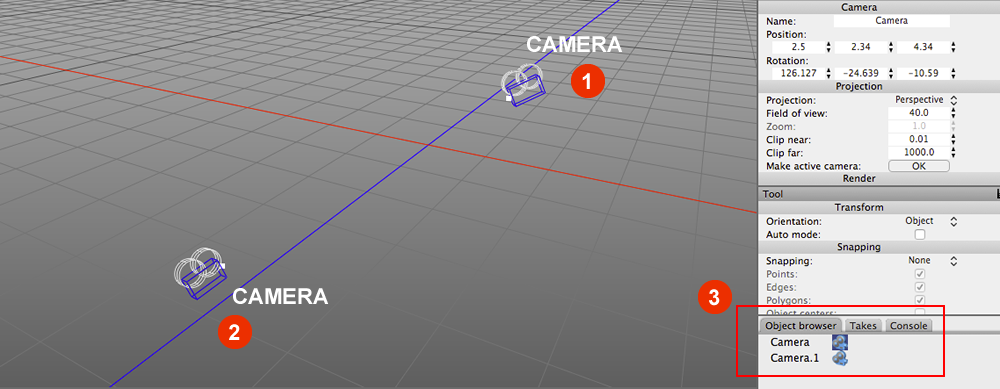
Camera one (1) has not moved. It is still at the same location. However camera two (2) as at a different location. You can see that there are now two cameras within the environment (3).
Imagine you are driving in a car. You are driving down the road looking out at the world through camera one (1). This is what the scene looks like when viewed through camera one. Notice how camera one is now high lighted, meaning we are looking through it as shown in the red box (1).
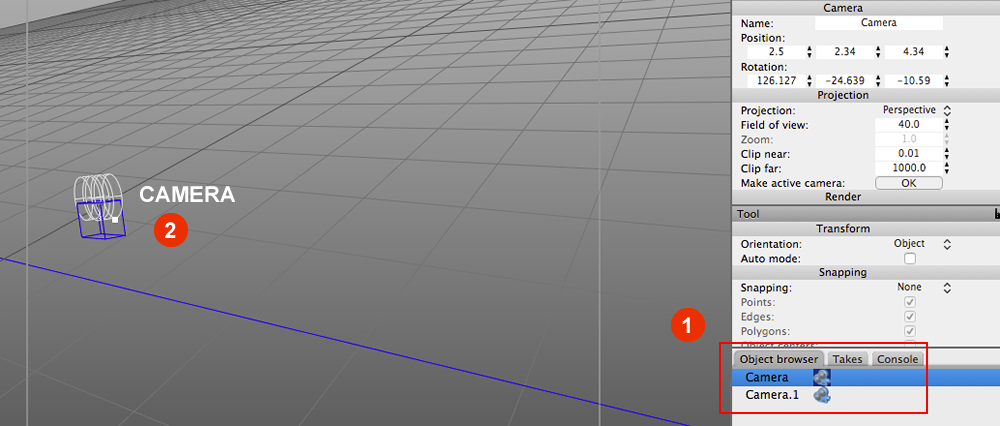
So this is your view as you drive down the street. Then, suddenly, you get hit by are car. You are in a bad car accident. Then you find youself floating above your body looking down at it. You can see medics working on yourself from above. How can this happen?
What has happened is you have switched view from camera one to camera two. Here is your view looking at the world through camera 2.
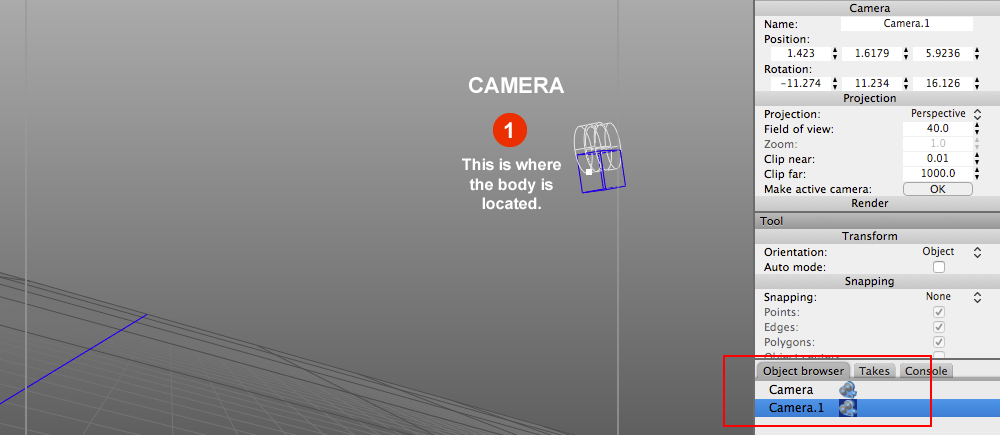
Notice in the red box how the view has switched from camera one to camera two. Looking out through camera two we can see camera one. Camera one is where your body is located. The trauma has caused you to switch your view from camera one to camera two.
This phenomenon is known as an out of body experience or OBE. OBE is experiencing yourself outside your body. It is caused by severe trauma. Medical science has struggled to explain OBE. Virtual reality shows you how it happens. Before the accident you were looking at the world through camera one. The accident caused your perspective to move from camera one to camera two. Now you are at viewing from another location within the environment. You are able to look down from outside your body because memory is surrounding space. Memory is the three dimensional space of virtual reality. Perspective can move outside the body because it is still within memory.
This is an example of how Proof Of Afterlife makes a practical contribution to medical science. For years medical science has struggled to understand how a person can find themselves outside their body. Yet there are millions who have seen it. They attempt to explain this away is random neuron firing. They discredit the user never realizing this actually happens.
It happens because memory is the surrounding dimension. Your perspective of the world can be anywhere because it is still within memory. Your viewpoint does not necessarily have to be at 0,0,0 located physically within the body. It can be anywhere. It takes OBE to see it. The theory predicts it. OBE shows it to be true.
Life and virtual reality have identical geometry. Virtual reality is made up of a camera surrounded by three-dimensional space. Life is the same. Life is made up of a point of view surrounded by three-dimensional space. I would go as far to say that the programming makeup of a virtual reality environment is similar to how reality is stored in the mind. Reality is not bit-mapped, like video. It is three dimensional geometry, like virtual reality.
3. Virtual Reality and NDE
Virtual Reality software is fully three-dimensional. That is fine for rendering static scenes. To make it truly realistic however, it also contains time. Inside a virtual reality environment you have unlimited length, width, and depth. You also have depth in time as well. This image shows the virtual reality environment and a timeline giving it depth in time.
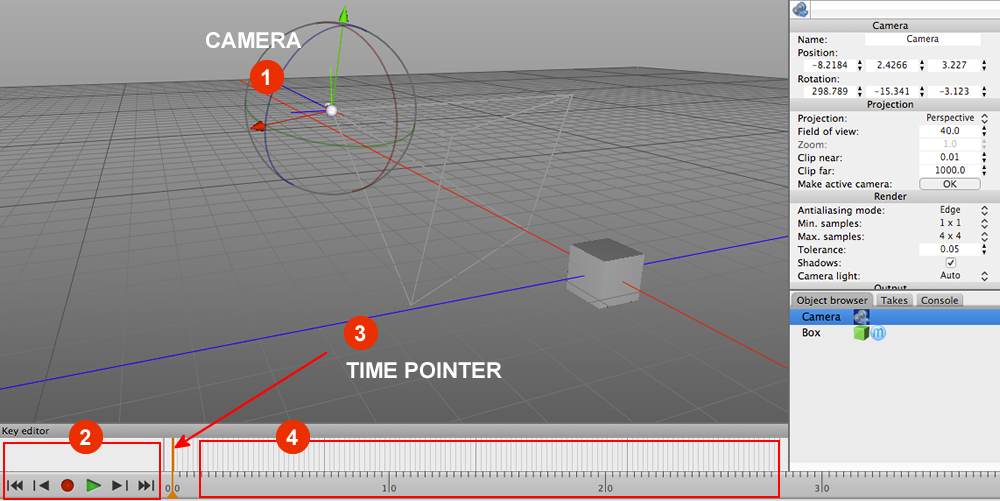
Now in this scene we have a camera (1) looking down at a box. In addition the software has the elements to give the environment depth in time. On the lower left, you have time controls (2). Using these controls can play, stop, and rewind the scene in time. Next you have the time pointer (3). Using the time pointer you can move about in time. The location of the time pointer acts like the present. Next you have a time line (4). The time pointer's location on the time line shows you exactly where you are in time. These time controls provide depth in time for a full virtual reality system.
Here is that same scene (above) looking through the camera.
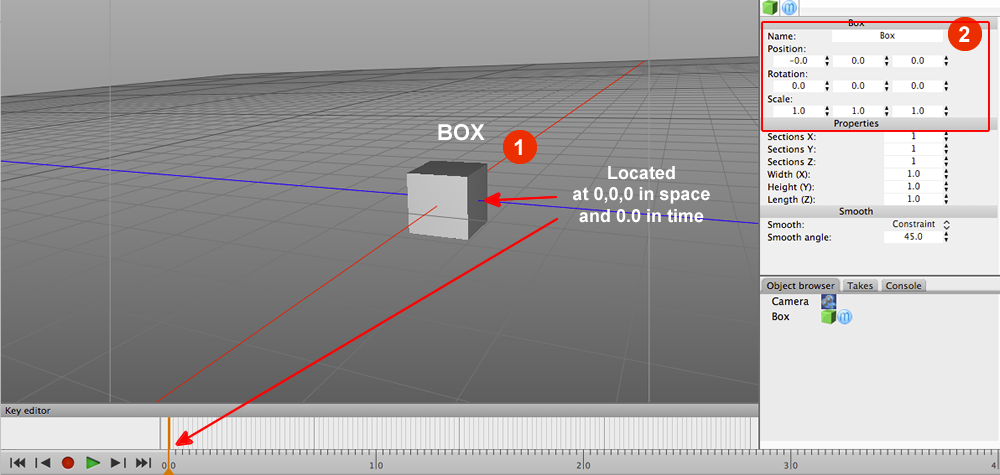
The box (1) is located at 0,0,0 in space (2) and 0.0 in time as shown. Virtual reality animators use the timeline to animate their scene. To animate a scene, animator will move the elements in space and timeline pointer in time as showh here:
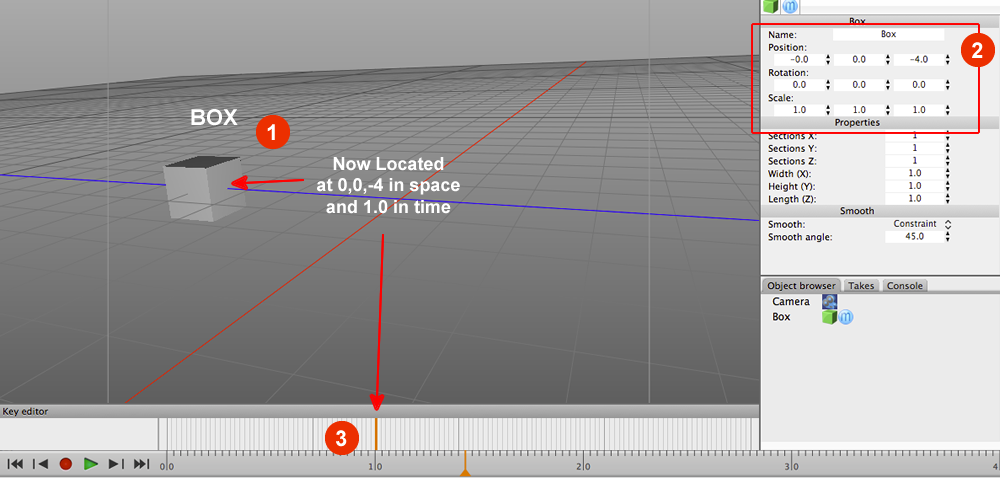
In this example I have moved the box (1) four units on the Z axis. You can see from the controls (2) that the location was changed from 0,0,0 to 0,0,-4 in space. I have moved the time ponter (3) to 1.0 second. You can see from the timeline the location pointer is set to 1.0 seconds. When we play the animation, from 0 to 1.0 seconds, the box will move four inches on the Z axis. The resulting animation would show the box sliding smoothly from location one to location two over the span of one second.
Thus virtual reality is a four-dimensional realm of length, width, depth and time. This is another instance of how Proof Of Afterlife can explain a mystery of medical science. Medical science is at a loss of how to explain the millions of accounts of near death experience or NDE. NDE accounts almost always include the time dimension commonly described as a life in review or visiting with relatives of the past and doctors don't know why.
What happens in NDE is the time pointer moves. Rather than being at the present, as we are during life, it gets moved to some point in the past. We can see that virtual reality has depth in time. Memory does too. When people experience NDE the controls on the timeline move. The time marker gets moved back in time to visit those environments of the past. You can do it in virtual reality. You can do it in memory too. With NDE the marker gets moved back in time where you can live in a scene of the past.
4. Virtual Reality And Afterlife
The process of creating a virtual reality animation is called modeling. It can take a team of 10 animators a month to create five minutes of animation. This is because everything in the environment has to be built. Every tree, building, or figure has to be built and installed in the environment. Modeling a three dimensional environment is takes a lot of time. It is hard, tedious work.
During life we model on the fly. Envision your memory is the physical realm of your environment. Envision the camera as your point of view. What would take animators years to build is done automatically as we go through life.
Envision the timeline as containing every modeled environment moment from the beginning of your life. What you have in memory is a huge, modeled four-dimensional realm of time and space. There is no magic there. This is how things are.
We have this magnificently, painstakingly crafted realm of time and space available to us all the time. We can access it at any moment. People who have experienced OBE have seen it with respect to space. People who have experienced NDE have seen it with respect to time. They have seen it. They are telling us it exists.
At the end of life, when our awareness is extinguished, we enter this realm. The end of life is not easy concept to understand. During life we look out from a single point like a camera. It is easy to conclude, at the end of life, we simply enter this realm as that same camera. That sounds plausible but that is NOT what happens.
The difference between life and afterlife is this. Imagine setting your time pointer back to one year ago. You would enter than environment. But here is the difference. During life one year ago you saw the environment through the camera. That camera represents one point. There are infinite points within that environment. You could go back one year ago, enter that environment, and view it from a location other than the camera. You could, if you wanted to, view that environment from anywhere within the environment. It doesn't have to be through the camera. The camera is just another point. That location is arbitrary.
What you experienced originally was one point. What you modeled is the entire environment. The relationship between what you experienced and what you modeled is one to infinity. One is location. The other is unlimited space.
What happens at death is expansion of awareness. Awareness goes into death as a point. It comes out of death as unlimited space. At death the camera opens up from point to space. It opens up from the present to time. What was formally a single point in space and time now opens up as space and time. Afterlife is infinitely greater than life. The accurate way to envision afterlife is to think of the point of the camera becoming the entire universe of space and time. At the moment life ends awareness becomes memory. Memory is ubiquitous. Memory is everywhere throughout time and space. Memory is the white light of knowledge that people who have experienced NDE describe. Afterlife is not contingent on space and time. It is space and time. At death you will become God.